Business Law Case Study: Assessing Negligence, Liability & Golf Injury
VerifiedAdded on 2023/06/11
|9
|1969
|56
Case Study
AI Summary
This case study examines the legal issues surrounding a golf injury, focusing on negligence and liability. It analyzes whether Paul can bring legal proceedings against Wayne, considering the assumption of risk under the Civil Liabilities Act 2003. The study further investigates potential negligence on the part of the golf club, particularly regarding exclusion clauses and their duty to warn players of risks. Finally, it assesses the damages Paul can claim for his personal injury, considering remoteness of damage, contributory negligence, and loss of earning capacity, referencing relevant sections of the Civil Liabilities Act and case law. The analysis concludes with advice to Paul regarding potential claims against the golf club for loss of earnings.
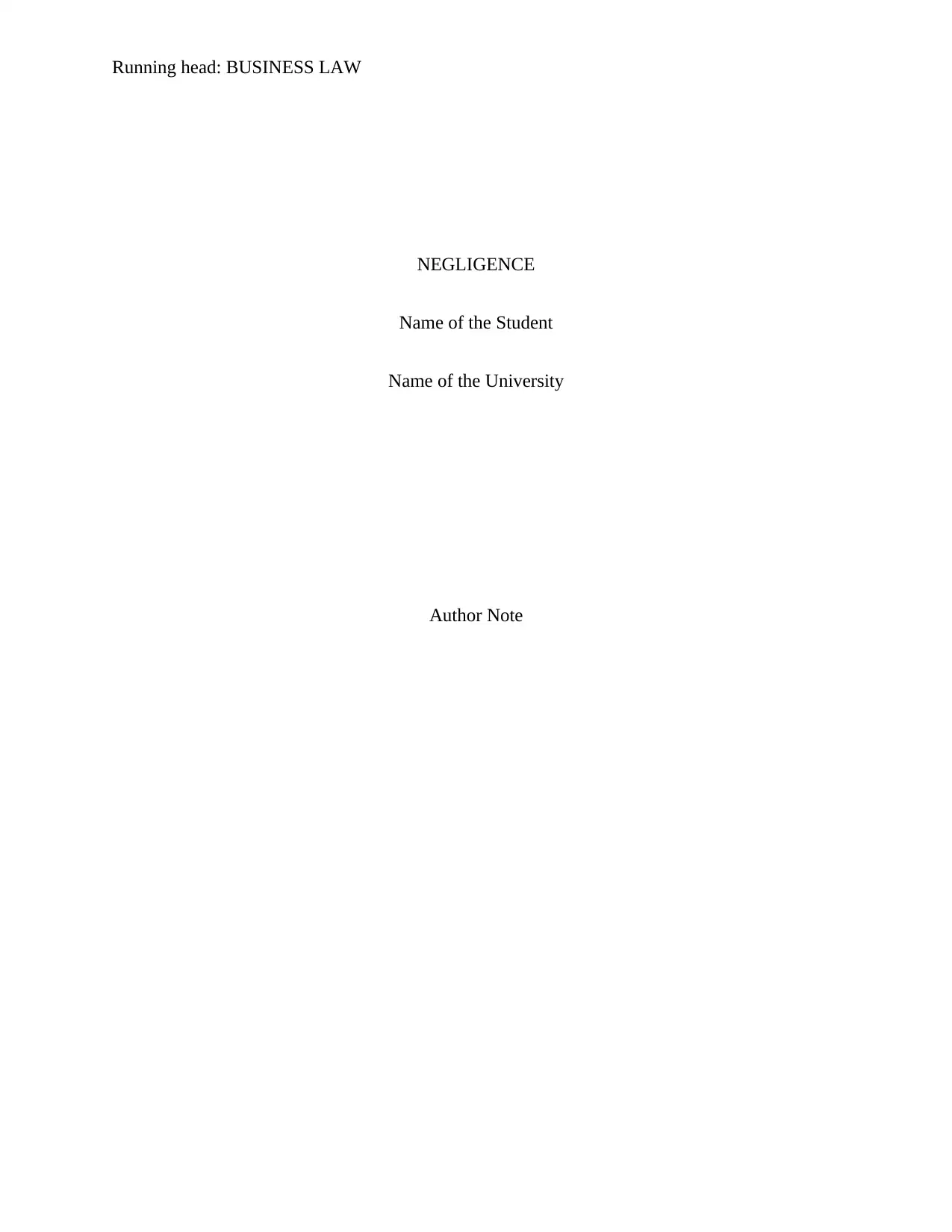
Running head: BUSINESS LAW
NEGLIGENCE
Name of the Student
Name of the University
Author Note
NEGLIGENCE
Name of the Student
Name of the University
Author Note
Paraphrase This Document
Need a fresh take? Get an instant paraphrase of this document with our AI Paraphraser
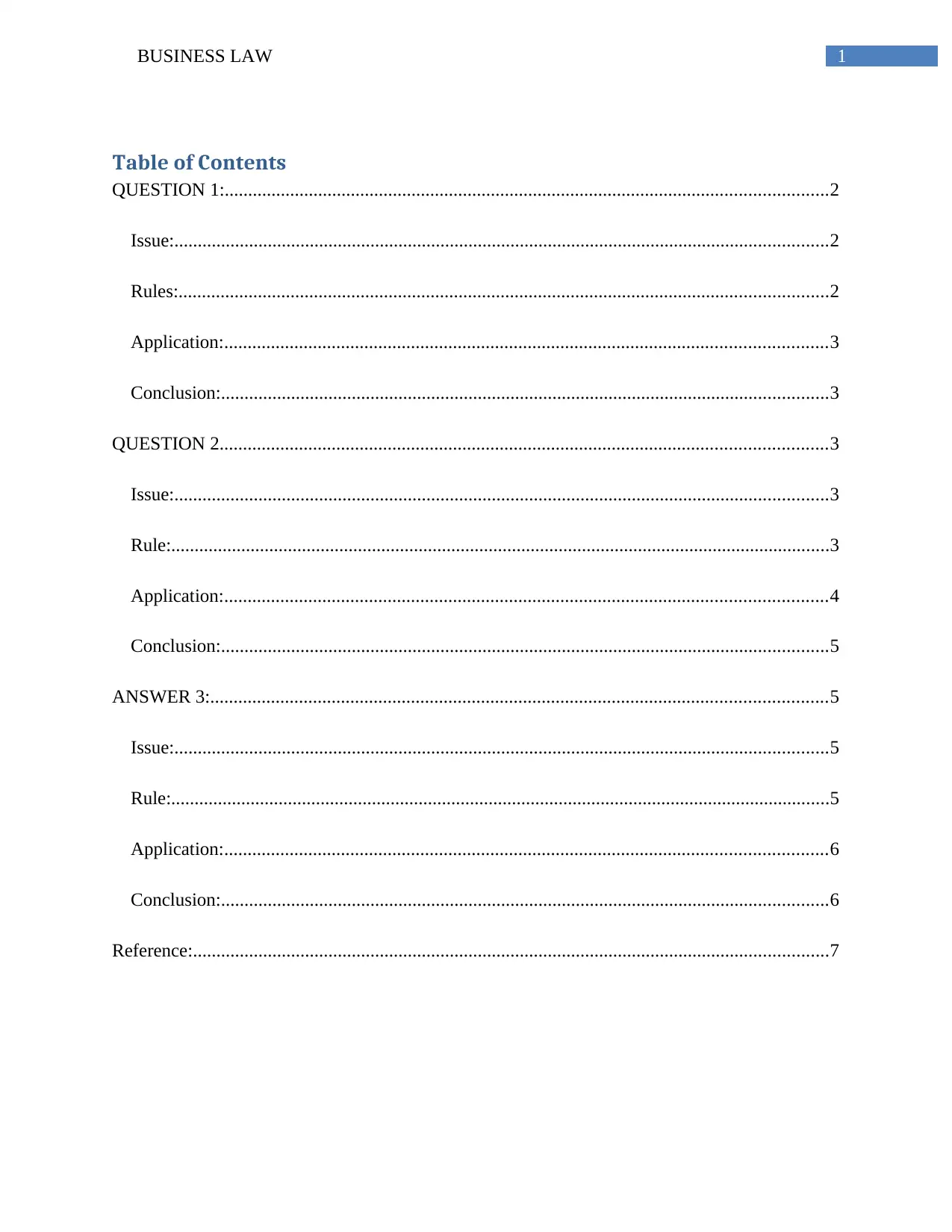
1BUSINESS LAW
Table of Contents
QUESTION 1:.................................................................................................................................2
Issue:............................................................................................................................................2
Rules:...........................................................................................................................................2
Application:.................................................................................................................................3
Conclusion:..................................................................................................................................3
QUESTION 2..................................................................................................................................3
Issue:............................................................................................................................................3
Rule:.............................................................................................................................................3
Application:.................................................................................................................................4
Conclusion:..................................................................................................................................5
ANSWER 3:....................................................................................................................................5
Issue:............................................................................................................................................5
Rule:.............................................................................................................................................5
Application:.................................................................................................................................6
Conclusion:..................................................................................................................................6
Reference:........................................................................................................................................7
Table of Contents
QUESTION 1:.................................................................................................................................2
Issue:............................................................................................................................................2
Rules:...........................................................................................................................................2
Application:.................................................................................................................................3
Conclusion:..................................................................................................................................3
QUESTION 2..................................................................................................................................3
Issue:............................................................................................................................................3
Rule:.............................................................................................................................................3
Application:.................................................................................................................................4
Conclusion:..................................................................................................................................5
ANSWER 3:....................................................................................................................................5
Issue:............................................................................................................................................5
Rule:.............................................................................................................................................5
Application:.................................................................................................................................6
Conclusion:..................................................................................................................................6
Reference:........................................................................................................................................7
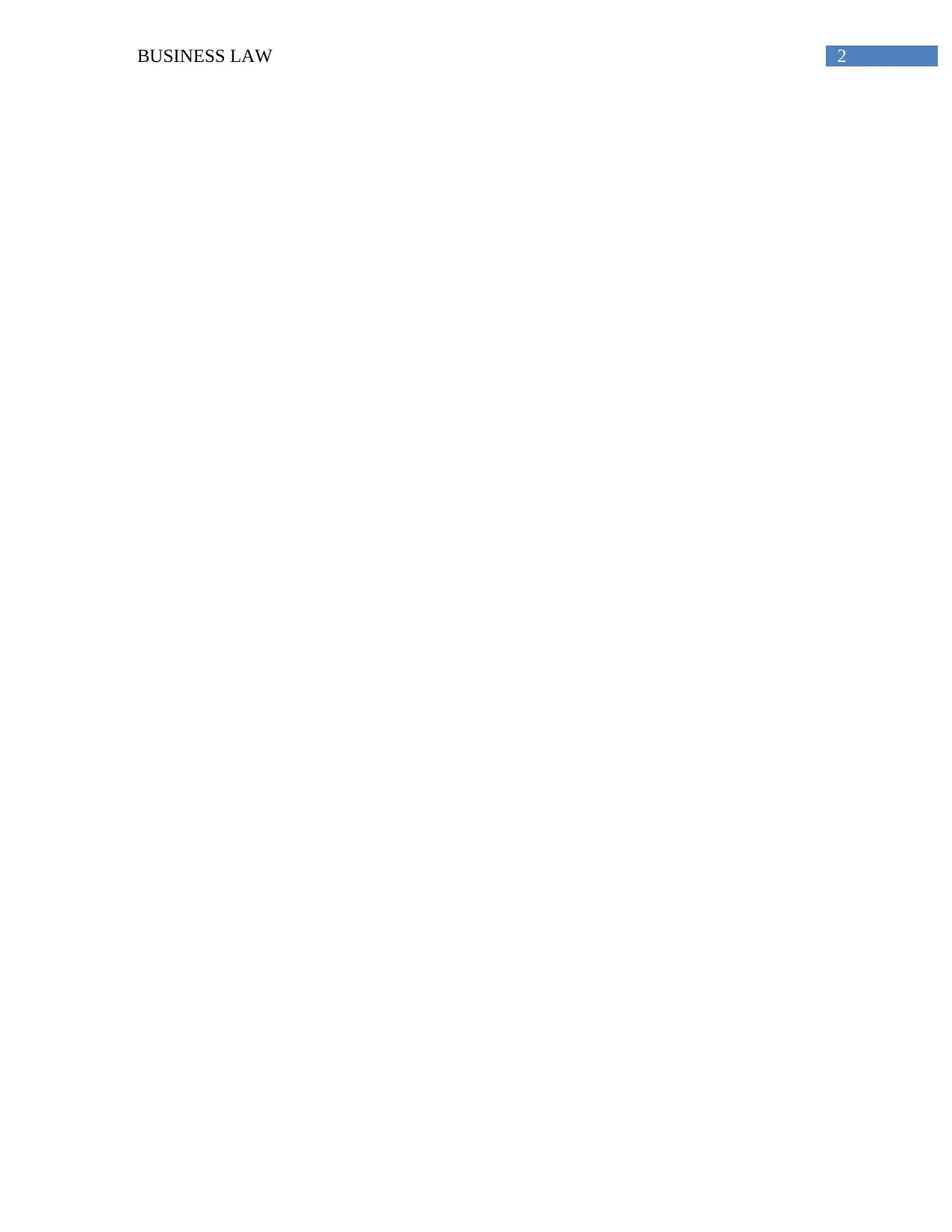
2BUSINESS LAW
⊘ This is a preview!⊘
Do you want full access?
Subscribe today to unlock all pages.

Trusted by 1+ million students worldwide
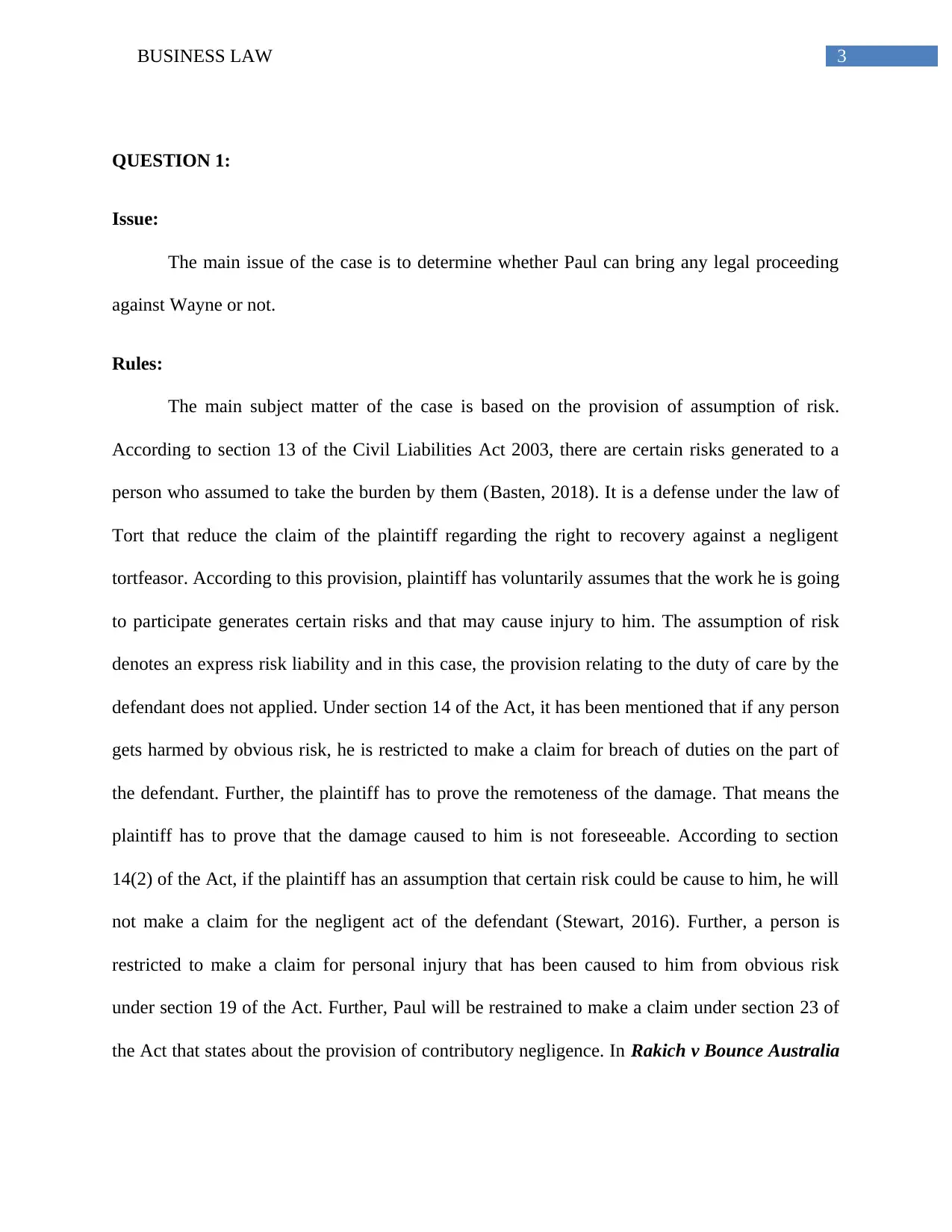
3BUSINESS LAW
QUESTION 1:
Issue:
The main issue of the case is to determine whether Paul can bring any legal proceeding
against Wayne or not.
Rules:
The main subject matter of the case is based on the provision of assumption of risk.
According to section 13 of the Civil Liabilities Act 2003, there are certain risks generated to a
person who assumed to take the burden by them (Basten, 2018). It is a defense under the law of
Tort that reduce the claim of the plaintiff regarding the right to recovery against a negligent
tortfeasor. According to this provision, plaintiff has voluntarily assumes that the work he is going
to participate generates certain risks and that may cause injury to him. The assumption of risk
denotes an express risk liability and in this case, the provision relating to the duty of care by the
defendant does not applied. Under section 14 of the Act, it has been mentioned that if any person
gets harmed by obvious risk, he is restricted to make a claim for breach of duties on the part of
the defendant. Further, the plaintiff has to prove the remoteness of the damage. That means the
plaintiff has to prove that the damage caused to him is not foreseeable. According to section
14(2) of the Act, if the plaintiff has an assumption that certain risk could be cause to him, he will
not make a claim for the negligent act of the defendant (Stewart, 2016). Further, a person is
restricted to make a claim for personal injury that has been caused to him from obvious risk
under section 19 of the Act. Further, Paul will be restrained to make a claim under section 23 of
the Act that states about the provision of contributory negligence. In Rakich v Bounce Australia
QUESTION 1:
Issue:
The main issue of the case is to determine whether Paul can bring any legal proceeding
against Wayne or not.
Rules:
The main subject matter of the case is based on the provision of assumption of risk.
According to section 13 of the Civil Liabilities Act 2003, there are certain risks generated to a
person who assumed to take the burden by them (Basten, 2018). It is a defense under the law of
Tort that reduce the claim of the plaintiff regarding the right to recovery against a negligent
tortfeasor. According to this provision, plaintiff has voluntarily assumes that the work he is going
to participate generates certain risks and that may cause injury to him. The assumption of risk
denotes an express risk liability and in this case, the provision relating to the duty of care by the
defendant does not applied. Under section 14 of the Act, it has been mentioned that if any person
gets harmed by obvious risk, he is restricted to make a claim for breach of duties on the part of
the defendant. Further, the plaintiff has to prove the remoteness of the damage. That means the
plaintiff has to prove that the damage caused to him is not foreseeable. According to section
14(2) of the Act, if the plaintiff has an assumption that certain risk could be cause to him, he will
not make a claim for the negligent act of the defendant (Stewart, 2016). Further, a person is
restricted to make a claim for personal injury that has been caused to him from obvious risk
under section 19 of the Act. Further, Paul will be restrained to make a claim under section 23 of
the Act that states about the provision of contributory negligence. In Rakich v Bounce Australia
Paraphrase This Document
Need a fresh take? Get an instant paraphrase of this document with our AI Paraphraser
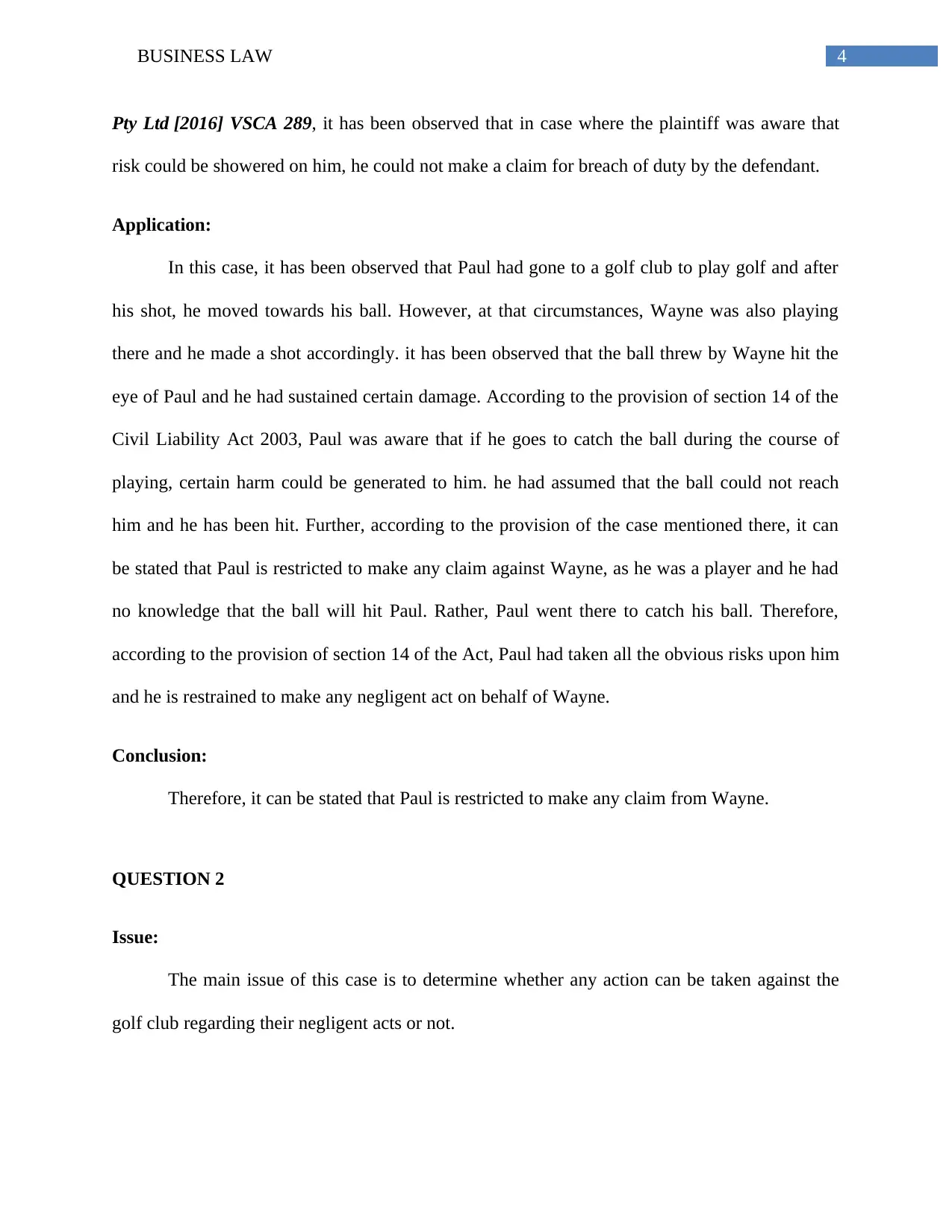
4BUSINESS LAW
Pty Ltd [2016] VSCA 289, it has been observed that in case where the plaintiff was aware that
risk could be showered on him, he could not make a claim for breach of duty by the defendant.
Application:
In this case, it has been observed that Paul had gone to a golf club to play golf and after
his shot, he moved towards his ball. However, at that circumstances, Wayne was also playing
there and he made a shot accordingly. it has been observed that the ball threw by Wayne hit the
eye of Paul and he had sustained certain damage. According to the provision of section 14 of the
Civil Liability Act 2003, Paul was aware that if he goes to catch the ball during the course of
playing, certain harm could be generated to him. he had assumed that the ball could not reach
him and he has been hit. Further, according to the provision of the case mentioned there, it can
be stated that Paul is restricted to make any claim against Wayne, as he was a player and he had
no knowledge that the ball will hit Paul. Rather, Paul went there to catch his ball. Therefore,
according to the provision of section 14 of the Act, Paul had taken all the obvious risks upon him
and he is restrained to make any negligent act on behalf of Wayne.
Conclusion:
Therefore, it can be stated that Paul is restricted to make any claim from Wayne.
QUESTION 2
Issue:
The main issue of this case is to determine whether any action can be taken against the
golf club regarding their negligent acts or not.
Pty Ltd [2016] VSCA 289, it has been observed that in case where the plaintiff was aware that
risk could be showered on him, he could not make a claim for breach of duty by the defendant.
Application:
In this case, it has been observed that Paul had gone to a golf club to play golf and after
his shot, he moved towards his ball. However, at that circumstances, Wayne was also playing
there and he made a shot accordingly. it has been observed that the ball threw by Wayne hit the
eye of Paul and he had sustained certain damage. According to the provision of section 14 of the
Civil Liability Act 2003, Paul was aware that if he goes to catch the ball during the course of
playing, certain harm could be generated to him. he had assumed that the ball could not reach
him and he has been hit. Further, according to the provision of the case mentioned there, it can
be stated that Paul is restricted to make any claim against Wayne, as he was a player and he had
no knowledge that the ball will hit Paul. Rather, Paul went there to catch his ball. Therefore,
according to the provision of section 14 of the Act, Paul had taken all the obvious risks upon him
and he is restrained to make any negligent act on behalf of Wayne.
Conclusion:
Therefore, it can be stated that Paul is restricted to make any claim from Wayne.
QUESTION 2
Issue:
The main issue of this case is to determine whether any action can be taken against the
golf club regarding their negligent acts or not.
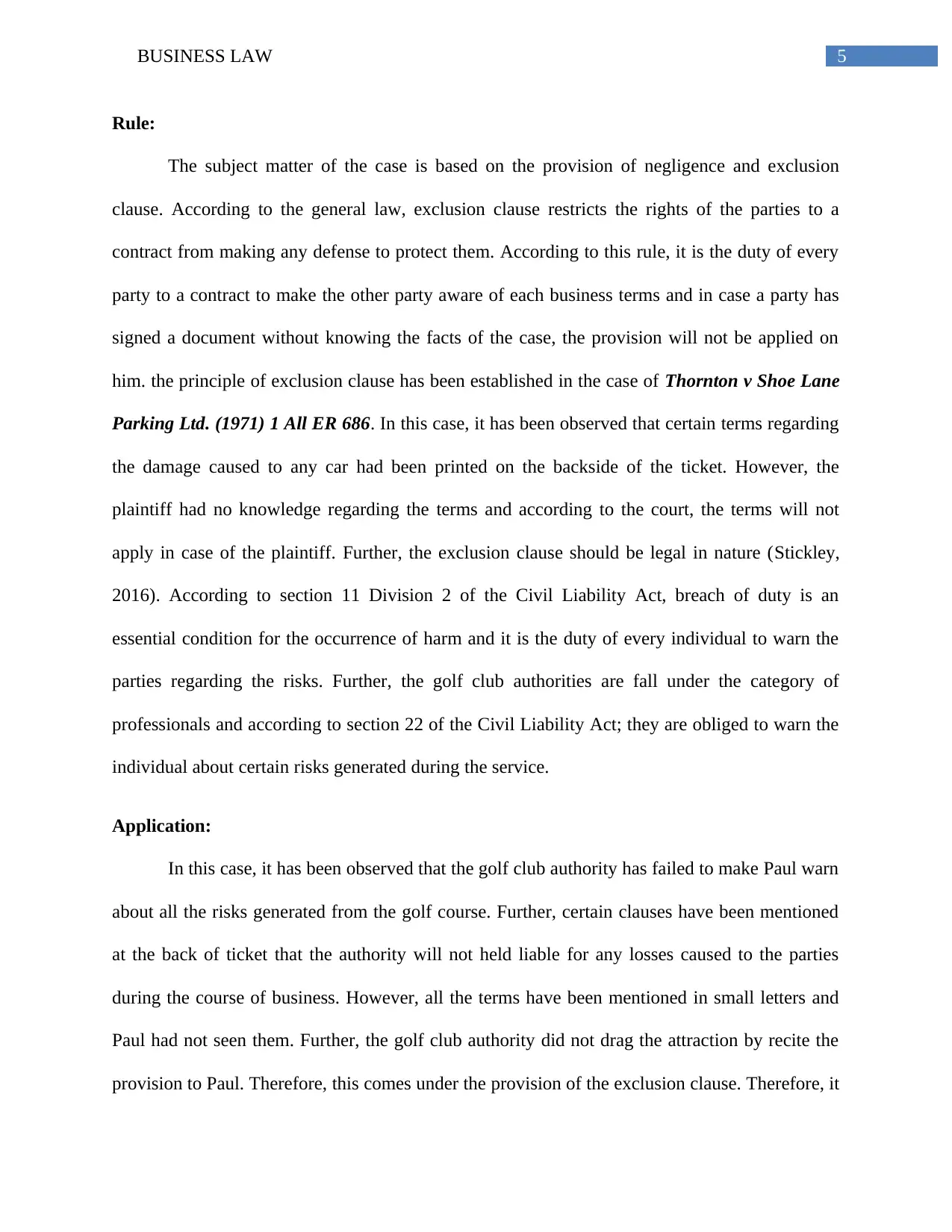
5BUSINESS LAW
Rule:
The subject matter of the case is based on the provision of negligence and exclusion
clause. According to the general law, exclusion clause restricts the rights of the parties to a
contract from making any defense to protect them. According to this rule, it is the duty of every
party to a contract to make the other party aware of each business terms and in case a party has
signed a document without knowing the facts of the case, the provision will not be applied on
him. the principle of exclusion clause has been established in the case of Thornton v Shoe Lane
Parking Ltd. (1971) 1 All ER 686. In this case, it has been observed that certain terms regarding
the damage caused to any car had been printed on the backside of the ticket. However, the
plaintiff had no knowledge regarding the terms and according to the court, the terms will not
apply in case of the plaintiff. Further, the exclusion clause should be legal in nature (Stickley,
2016). According to section 11 Division 2 of the Civil Liability Act, breach of duty is an
essential condition for the occurrence of harm and it is the duty of every individual to warn the
parties regarding the risks. Further, the golf club authorities are fall under the category of
professionals and according to section 22 of the Civil Liability Act; they are obliged to warn the
individual about certain risks generated during the service.
Application:
In this case, it has been observed that the golf club authority has failed to make Paul warn
about all the risks generated from the golf course. Further, certain clauses have been mentioned
at the back of ticket that the authority will not held liable for any losses caused to the parties
during the course of business. However, all the terms have been mentioned in small letters and
Paul had not seen them. Further, the golf club authority did not drag the attraction by recite the
provision to Paul. Therefore, this comes under the provision of the exclusion clause. Therefore, it
Rule:
The subject matter of the case is based on the provision of negligence and exclusion
clause. According to the general law, exclusion clause restricts the rights of the parties to a
contract from making any defense to protect them. According to this rule, it is the duty of every
party to a contract to make the other party aware of each business terms and in case a party has
signed a document without knowing the facts of the case, the provision will not be applied on
him. the principle of exclusion clause has been established in the case of Thornton v Shoe Lane
Parking Ltd. (1971) 1 All ER 686. In this case, it has been observed that certain terms regarding
the damage caused to any car had been printed on the backside of the ticket. However, the
plaintiff had no knowledge regarding the terms and according to the court, the terms will not
apply in case of the plaintiff. Further, the exclusion clause should be legal in nature (Stickley,
2016). According to section 11 Division 2 of the Civil Liability Act, breach of duty is an
essential condition for the occurrence of harm and it is the duty of every individual to warn the
parties regarding the risks. Further, the golf club authorities are fall under the category of
professionals and according to section 22 of the Civil Liability Act; they are obliged to warn the
individual about certain risks generated during the service.
Application:
In this case, it has been observed that the golf club authority has failed to make Paul warn
about all the risks generated from the golf course. Further, certain clauses have been mentioned
at the back of ticket that the authority will not held liable for any losses caused to the parties
during the course of business. However, all the terms have been mentioned in small letters and
Paul had not seen them. Further, the golf club authority did not drag the attraction by recite the
provision to Paul. Therefore, this comes under the provision of the exclusion clause. Therefore, it
⊘ This is a preview!⊘
Do you want full access?
Subscribe today to unlock all pages.

Trusted by 1+ million students worldwide
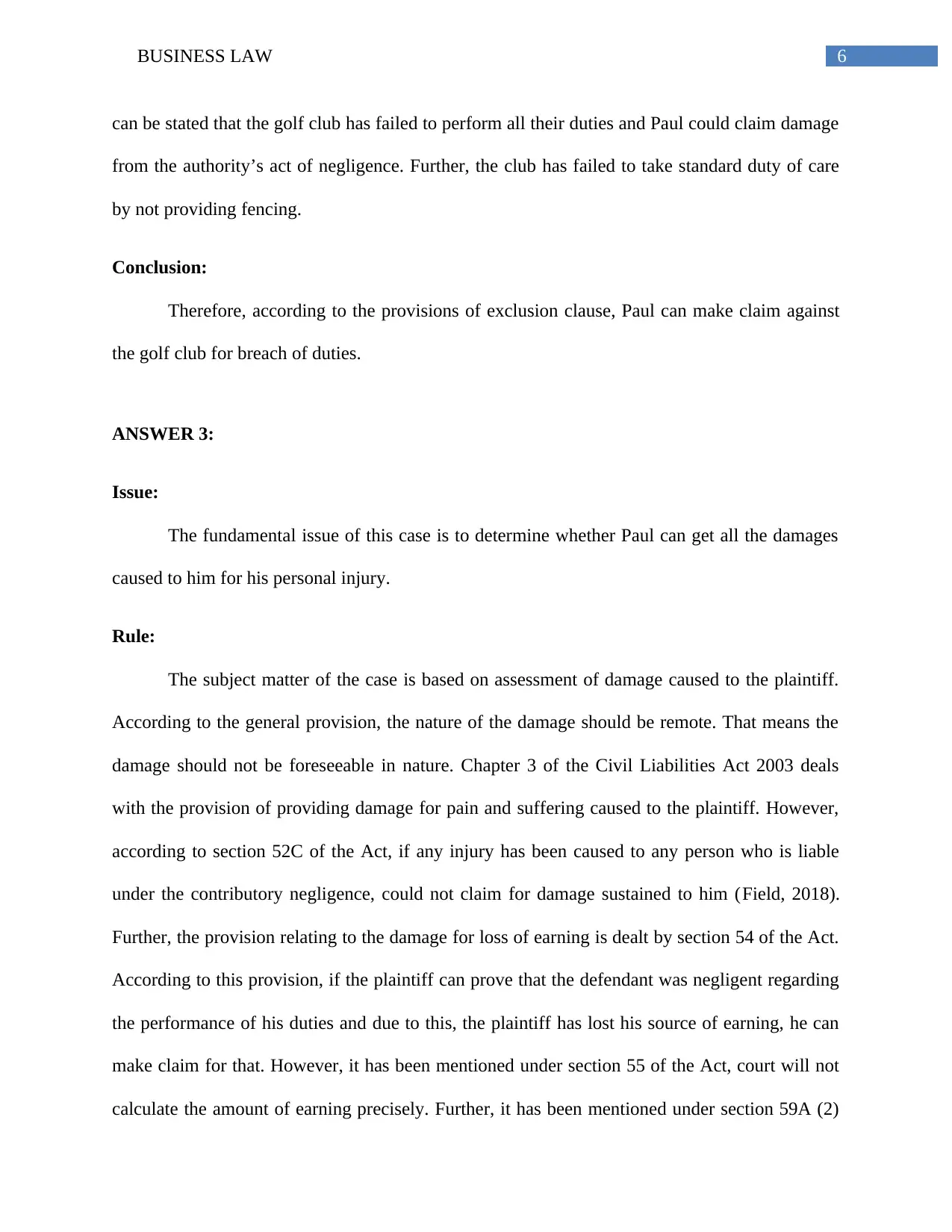
6BUSINESS LAW
can be stated that the golf club has failed to perform all their duties and Paul could claim damage
from the authority’s act of negligence. Further, the club has failed to take standard duty of care
by not providing fencing.
Conclusion:
Therefore, according to the provisions of exclusion clause, Paul can make claim against
the golf club for breach of duties.
ANSWER 3:
Issue:
The fundamental issue of this case is to determine whether Paul can get all the damages
caused to him for his personal injury.
Rule:
The subject matter of the case is based on assessment of damage caused to the plaintiff.
According to the general provision, the nature of the damage should be remote. That means the
damage should not be foreseeable in nature. Chapter 3 of the Civil Liabilities Act 2003 deals
with the provision of providing damage for pain and suffering caused to the plaintiff. However,
according to section 52C of the Act, if any injury has been caused to any person who is liable
under the contributory negligence, could not claim for damage sustained to him (Field, 2018).
Further, the provision relating to the damage for loss of earning is dealt by section 54 of the Act.
According to this provision, if the plaintiff can prove that the defendant was negligent regarding
the performance of his duties and due to this, the plaintiff has lost his source of earning, he can
make claim for that. However, it has been mentioned under section 55 of the Act, court will not
calculate the amount of earning precisely. Further, it has been mentioned under section 59A (2)
can be stated that the golf club has failed to perform all their duties and Paul could claim damage
from the authority’s act of negligence. Further, the club has failed to take standard duty of care
by not providing fencing.
Conclusion:
Therefore, according to the provisions of exclusion clause, Paul can make claim against
the golf club for breach of duties.
ANSWER 3:
Issue:
The fundamental issue of this case is to determine whether Paul can get all the damages
caused to him for his personal injury.
Rule:
The subject matter of the case is based on assessment of damage caused to the plaintiff.
According to the general provision, the nature of the damage should be remote. That means the
damage should not be foreseeable in nature. Chapter 3 of the Civil Liabilities Act 2003 deals
with the provision of providing damage for pain and suffering caused to the plaintiff. However,
according to section 52C of the Act, if any injury has been caused to any person who is liable
under the contributory negligence, could not claim for damage sustained to him (Field, 2018).
Further, the provision relating to the damage for loss of earning is dealt by section 54 of the Act.
According to this provision, if the plaintiff can prove that the defendant was negligent regarding
the performance of his duties and due to this, the plaintiff has lost his source of earning, he can
make claim for that. However, it has been mentioned under section 55 of the Act, court will not
calculate the amount of earning precisely. Further, it has been mentioned under section 59A (2)
Paraphrase This Document
Need a fresh take? Get an instant paraphrase of this document with our AI Paraphraser
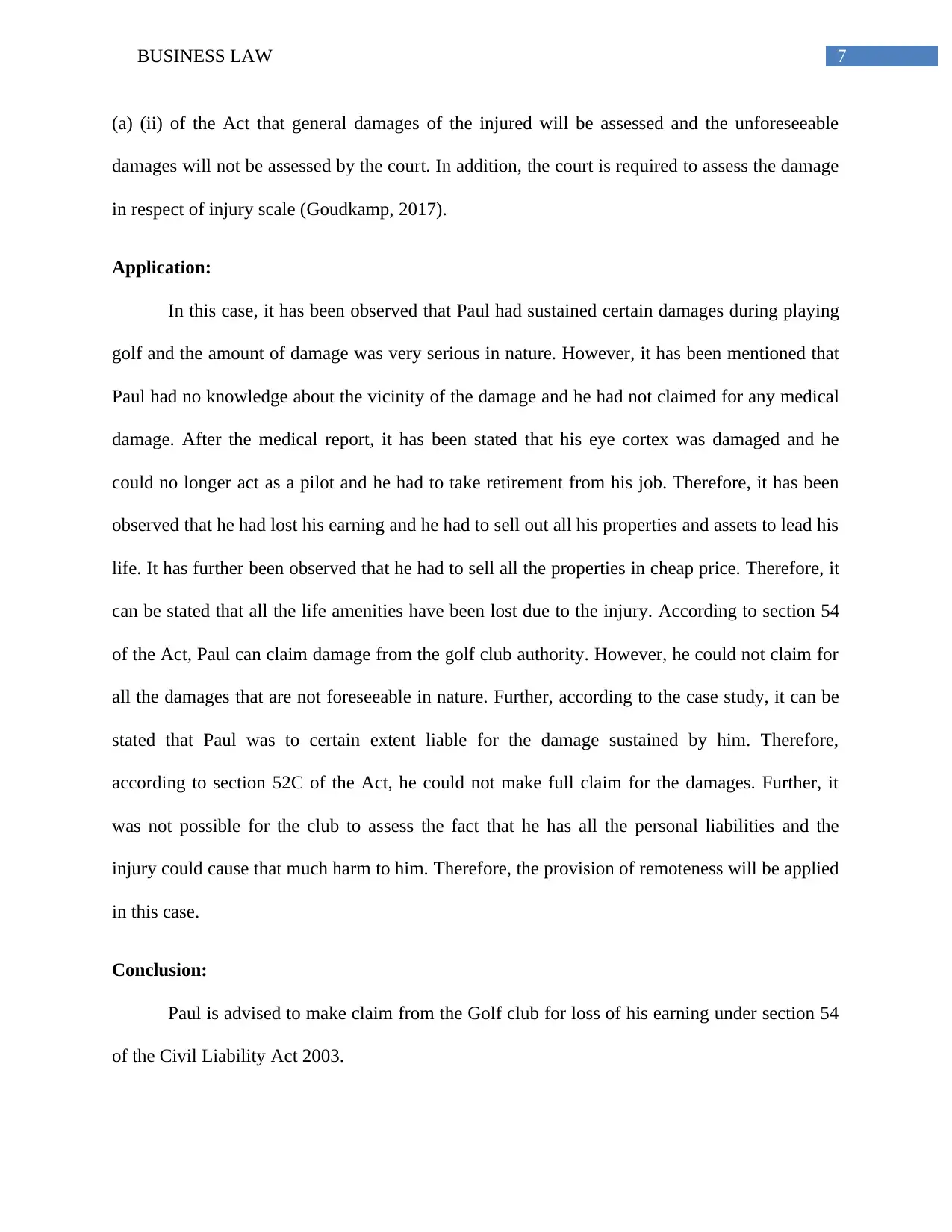
7BUSINESS LAW
(a) (ii) of the Act that general damages of the injured will be assessed and the unforeseeable
damages will not be assessed by the court. In addition, the court is required to assess the damage
in respect of injury scale (Goudkamp, 2017).
Application:
In this case, it has been observed that Paul had sustained certain damages during playing
golf and the amount of damage was very serious in nature. However, it has been mentioned that
Paul had no knowledge about the vicinity of the damage and he had not claimed for any medical
damage. After the medical report, it has been stated that his eye cortex was damaged and he
could no longer act as a pilot and he had to take retirement from his job. Therefore, it has been
observed that he had lost his earning and he had to sell out all his properties and assets to lead his
life. It has further been observed that he had to sell all the properties in cheap price. Therefore, it
can be stated that all the life amenities have been lost due to the injury. According to section 54
of the Act, Paul can claim damage from the golf club authority. However, he could not claim for
all the damages that are not foreseeable in nature. Further, according to the case study, it can be
stated that Paul was to certain extent liable for the damage sustained by him. Therefore,
according to section 52C of the Act, he could not make full claim for the damages. Further, it
was not possible for the club to assess the fact that he has all the personal liabilities and the
injury could cause that much harm to him. Therefore, the provision of remoteness will be applied
in this case.
Conclusion:
Paul is advised to make claim from the Golf club for loss of his earning under section 54
of the Civil Liability Act 2003.
(a) (ii) of the Act that general damages of the injured will be assessed and the unforeseeable
damages will not be assessed by the court. In addition, the court is required to assess the damage
in respect of injury scale (Goudkamp, 2017).
Application:
In this case, it has been observed that Paul had sustained certain damages during playing
golf and the amount of damage was very serious in nature. However, it has been mentioned that
Paul had no knowledge about the vicinity of the damage and he had not claimed for any medical
damage. After the medical report, it has been stated that his eye cortex was damaged and he
could no longer act as a pilot and he had to take retirement from his job. Therefore, it has been
observed that he had lost his earning and he had to sell out all his properties and assets to lead his
life. It has further been observed that he had to sell all the properties in cheap price. Therefore, it
can be stated that all the life amenities have been lost due to the injury. According to section 54
of the Act, Paul can claim damage from the golf club authority. However, he could not claim for
all the damages that are not foreseeable in nature. Further, according to the case study, it can be
stated that Paul was to certain extent liable for the damage sustained by him. Therefore,
according to section 52C of the Act, he could not make full claim for the damages. Further, it
was not possible for the club to assess the fact that he has all the personal liabilities and the
injury could cause that much harm to him. Therefore, the provision of remoteness will be applied
in this case.
Conclusion:
Paul is advised to make claim from the Golf club for loss of his earning under section 54
of the Civil Liability Act 2003.
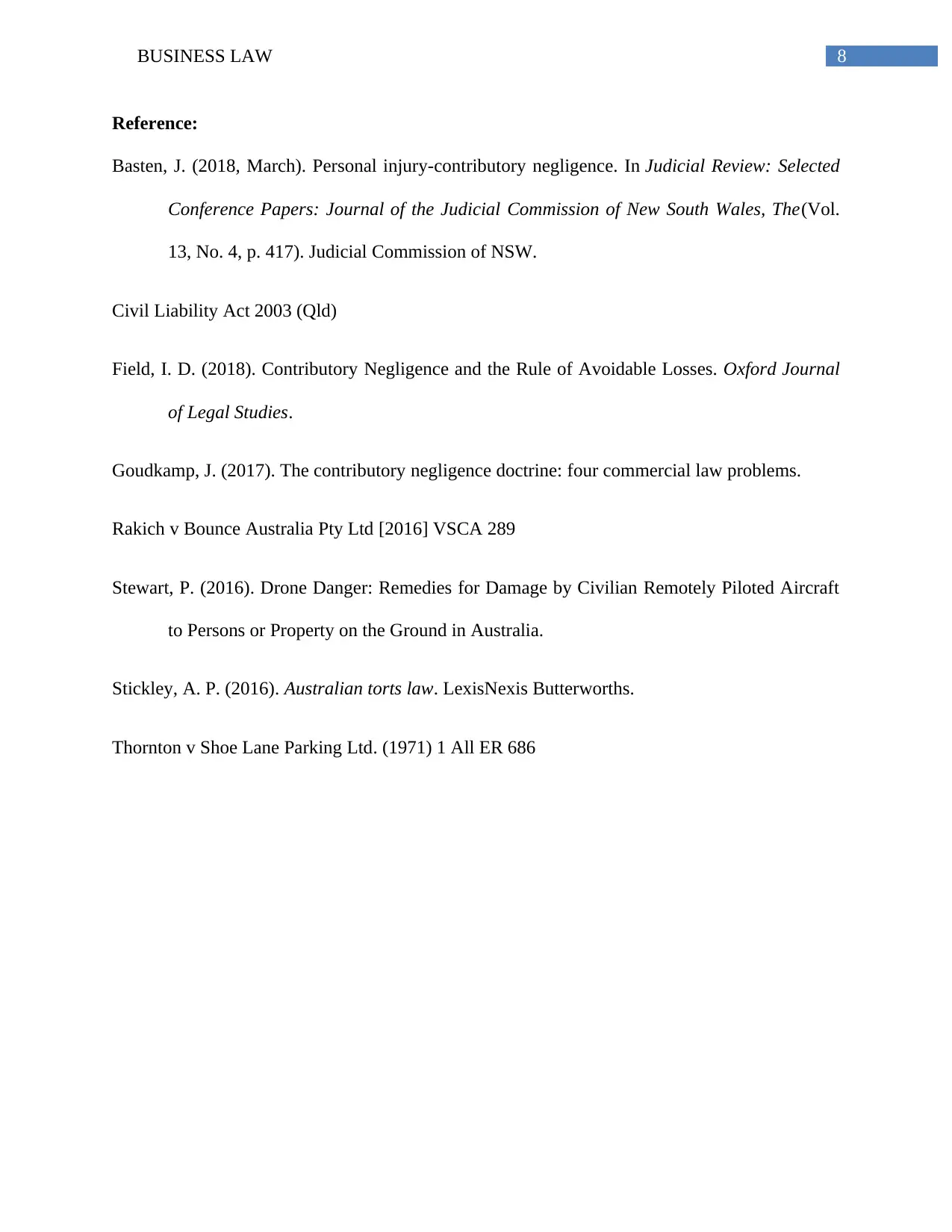
8BUSINESS LAW
Reference:
Basten, J. (2018, March). Personal injury-contributory negligence. In Judicial Review: Selected
Conference Papers: Journal of the Judicial Commission of New South Wales, The(Vol.
13, No. 4, p. 417). Judicial Commission of NSW.
Civil Liability Act 2003 (Qld)
Field, I. D. (2018). Contributory Negligence and the Rule of Avoidable Losses. Oxford Journal
of Legal Studies.
Goudkamp, J. (2017). The contributory negligence doctrine: four commercial law problems.
Rakich v Bounce Australia Pty Ltd [2016] VSCA 289
Stewart, P. (2016). Drone Danger: Remedies for Damage by Civilian Remotely Piloted Aircraft
to Persons or Property on the Ground in Australia.
Stickley, A. P. (2016). Australian torts law. LexisNexis Butterworths.
Thornton v Shoe Lane Parking Ltd. (1971) 1 All ER 686
Reference:
Basten, J. (2018, March). Personal injury-contributory negligence. In Judicial Review: Selected
Conference Papers: Journal of the Judicial Commission of New South Wales, The(Vol.
13, No. 4, p. 417). Judicial Commission of NSW.
Civil Liability Act 2003 (Qld)
Field, I. D. (2018). Contributory Negligence and the Rule of Avoidable Losses. Oxford Journal
of Legal Studies.
Goudkamp, J. (2017). The contributory negligence doctrine: four commercial law problems.
Rakich v Bounce Australia Pty Ltd [2016] VSCA 289
Stewart, P. (2016). Drone Danger: Remedies for Damage by Civilian Remotely Piloted Aircraft
to Persons or Property on the Ground in Australia.
Stickley, A. P. (2016). Australian torts law. LexisNexis Butterworths.
Thornton v Shoe Lane Parking Ltd. (1971) 1 All ER 686
⊘ This is a preview!⊘
Do you want full access?
Subscribe today to unlock all pages.

Trusted by 1+ million students worldwide
1 out of 9
Related Documents
Your All-in-One AI-Powered Toolkit for Academic Success.
+13062052269
info@desklib.com
Available 24*7 on WhatsApp / Email
![[object Object]](/_next/static/media/star-bottom.7253800d.svg)
Unlock your academic potential
Copyright © 2020–2025 A2Z Services. All Rights Reserved. Developed and managed by ZUCOL.





